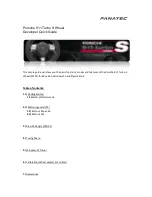
ON-VEHICLE SERVICE
WARNING:
Before attempting service of any type on fuel system, fol-
lowing cautions should be always observed.
Disconnect negative cable at battery.
DO NOT smoke, and place “NO SMOKING” signs near
work area.
Be sure to have CO
2
fire extinguisher handy.
Be sure to perform work in a well-ventilated area and
away from any open flames (such as gas hot heater).
Wear safety glasses.
To relieve fuel vapor pressure in fuel tank, remove fuel
filler cap from fuel filler neck and then reinstall it.
As fuel feed line is still under high fuel pressure even
after engine was stopped, loosening or disconnecting
fuel feed line directly may cause dangerous spout of
fuel to occur where loosened or disconnected.
Before loosening or disconnecting fuel feed line, make
sure to relieve fuel pressure according to procedure
described on p. 6-4.
A small amount of fuel may be released after the fuel
line is disconnected. In order to reduce the chance of
personal injury, cover the fitting to be disconnected
with a shop cloth. Be sure to put that cloth in an ap-
proved container when disconnection is completed.
Note that fuel hose connection varies with each type
of pipe. Be sure to connect and clamp each hose cor-
rectly referring to the left figure.
Clamp securely at a position 3 to 7 mm
(0.12 – 0.27 in.) from hose end.
With short pipe, fit hose as far as it reaches
pipe joint as shown.
Clamp securely at a position 3 to 7
mm (0.12 – 0.27 in.) from hose end.
With following type pipe, fit hose as far as its peripheral pro-
jection as shown.
Clamp securely at a position 3
to 7 mm 10.12 – 0.27 in.) from
hose end.
With bent pipe, fit hose as far as its bent part as shown or till
pipe is about 20 to 30 mm (0.79-1.18 in.) into the hose.
Clamp securely at a position
3 to 7 mm (0.12 – 0.27 in.)
from hose end.
With straight pipe, fit hose till pipe is about 20 to 30 mm
(0.79-1.18 in.) in the hose.
20 to 30 mm
(0.79 – 1.18 in.)
Pipe
Hose
Clamp
Hose
Clamp
FUEL LINES
Due to the fact that fuel feed line is under high pressure, use special
care when servicing it.
INSPECTION
Visually inspect fuel lines for evidence of fuel leakage, hose crack
and deterioration, or damage.
Make sure all clamps are secure.
Replace parts as needed.
6C-2
ENGINE FUEL
SH410
















































